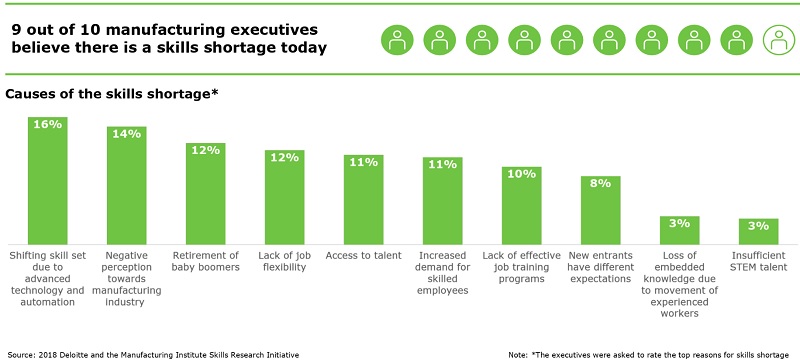Deloitte industrial manufacturing outlook tracks digitalization’s steady march
Businesses large and small are pursuing automation to combat the skills gap and make the most of current employees.
Latest Material Handling News
Registration open for Pack Expo International 2024 Walmart chooses Swisslog AS/RS and software for third milk processing facility NetLogistik partners with Vuzix subsidiary Moviynt to offer mobility solutions for warehouses Lucas Watson appointed CSO for Körber’s Parcel Logistics business in North America Hyster recognizes Dealers of Distinction for 2023 More NewsThe industrial manufacturing industry is in a unique position in the coming year, according to Deloitte’s 2019 Outlook on Industrial Manufacturing.
The outlook indicates that although output, utilization and financial performance are up, trade tensions are causing doubt, skilled talent is in short supply, and supply chains are struggling to match demand.
Deloitte’s Paul Wellener, leader of the U.S. Industrial Products and Services practice, starts with the good news. Job numbers remain strong, revisions notwithstanding, and Wellener remains pleased with the momentum he sees across the industry.
“It’s a solid time period to be a U.S. or even global manufacturer,” he says. “Despite some talk of a slowdown, we and our customers’ businesses are looking strong for 2019.”
The outlook supports the findings of Deloitte’s skills gap and digital frontrunner studies, Wellener says, which indicate increased adoption of digital technologies in manufacturing. He notes more spending in areas like automation, robotics, connectedness, Internet of Things and myriad devices.

On top of all of this, the report suggests the move toward digital and advanced technologies is transforming the industry and is likely to determine the fate of many companies.
“When industry representatives gather to speak with financial analysts, the topic of digitalization is throughout,” Wellener says. “There has been a relatively marked increase in the penetration of automation over the last couple of years. We see rapid convergence of technology and digitalization.”
Wellener looked at businesses large and small, and estimates larger manufacturers have added some significant form of automation to almost 2/3 of their operations. Smaller businesses are not tracking as heavily, but still 40-50% are investing in technology and automation.
“Larger organizations are not just automating in their manufacturing operations and supply chain, but there are a lot of applications of automatic processes in white collar roles,” Wellener adds. “Many are motivated by the skills gap to help free the folks they have to deal with other things. We’re in a war for talent in all industries, and it’s easier to take someone inside who is familiar and give them opportunities than to find someone outside.”
Wellener emphasizes there is no finish line for digitalization. It’s like lean manufacturing, he says. When are you done? Never.
“I don’t think we have anybody at what could be called ‘full digitalization.’ A lot of people are making a lot of progress, but it still feels not as programmatic as it could be,” Wellener says, recalling his experience at CES, which also featured plentiful examples of point solutions and fewer integrated solutions. “Despite activity and investment, the weaving together of everything is still not there.”
Talent will continue to be a big challenge, Wellener says, citing research projecting 2.4 million unfilled jobs over the next decade.
“It will involve government, industry, trade associations, labor unions, education, and more. It’s a multifaceted goal,” he says. “Even with all these innovations and technologies, you still need people to make them work.”
Other insights from the study include:
● Turning to mergers and acquisitions (M&A) amid political uncertainties and an influx of digital technologies: U.S. industrial manufacturing deals recorded over $65 billion in year-to-date M&A deal values in 2018, an increase of more than 30% compared to 2017. M&A in 2019 will be driven by continued business confidence and an increasing focus of U.S. firms to enhance their geographic presence and strengthen their product portfolios, as well as eagerness to invest in technology and innovation.
● Building resilience into the supply network to prepare for trade and tariff uncertainties: Current trade uncertainties offer an opportunity for manufacturers to reevaluate their supply and distribution networks in 2019. To build resiliency into their networks they may consider identifying new suppliers in certain regions, remapping their distribution networks, creating new pricing models or moving production.
● Building digital in the core: Nearly half of manufacturers (49%) are using a form of automation in their business, with plans to increase use across the business from production to supply chain/logistics and maintenance, repair and aftermarket service in the coming year.

Article Topics
Latest in Materials Handling
Registration open for Pack Expo International 2024 Walmart chooses Swisslog AS/RS and software for third milk processing facility NetLogistik partners with Vuzix subsidiary Moviynt to offer mobility solutions for warehouses Materials Handling Robotics: The new world of heterogeneous robotic integration BSLBATT is looking for new distributors and resellers worldwide Lucas Watson appointed CSO for Körber’s Parcel Logistics business in North America Hyster recognizes Dealers of Distinction for 2023 More Materials HandlingAbout the Author
Subscribe to Materials Handling Magazine

Find out what the world's most innovative companies are doing to improve productivity in their plants and distribution centers.
Start your FREE subscription today.
April 2024 Modern Materials Handling

Latest Resources










